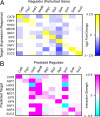A network biology approach to aging in yeast
- PMID: 19164565
- PMCID: PMC2629491
- DOI: 10.1073/pnas.0812551106
A network biology approach to aging in yeast
Abstract
In this study, a reverse-engineering strategy was used to infer and analyze the structure and function of an aging and glucose repressed gene regulatory network in the budding yeast Saccharomyces cerevisiae. The method uses transcriptional perturbations to model the functional interactions between genes as a system of first-order ordinary differential equations. The resulting network model correctly identified the known interactions of key regulators in a 10-gene network from the Snf1 signaling pathway, which is required for expression of glucose-repressed genes upon calorie restriction. The majority of interactions predicted by the network model were confirmed using promoter-reporter gene fusions in gene-deletion mutants and chromatin immunoprecipitation experiments, revealing a more complex network architecture than previously appreciated. The reverse-engineered network model also predicted an unexpected role for transcriptional regulation of the SNF1 gene by hexose kinase enzyme/transcriptional repressor Hxk2, Mediator subunit Med8, and transcriptional repressor Mig1. These interactions were validated experimentally and used to design new experiments demonstrating Snf1 and its transcriptional regulators Hxk2 and Mig1 as modulators of chronological lifespan. This work demonstrates the value of using network inference methods to identify and characterize the regulators of complex phenotypes, such as aging.
Conflict of interest statement
The authors declare no conflict of interest.
Figures




References
-
- Bishop NA, Guarente L. Genetic links between diet and lifespan: shared mechanisms from yeast to humans. Nat Rev Genet. 2007;8:835–844. - PubMed
-
- Fabrizio P, Longo VD. The chronological life span of Saccharomyces cerevisiae. Aging Cell. 2003;2:73–81. - PubMed
-
- Lin SJ, Defossez PA, Guarente L. Requirement of NAD and SIR2 for life-span extension by calorie restriction in Saccharomyces cerevisiae. Science. 2000;289:2126–2128. - PubMed
Publication types
MeSH terms
Substances
Grants and funding
LinkOut - more resources
Full Text Sources
Other Literature Sources
Molecular Biology Databases

